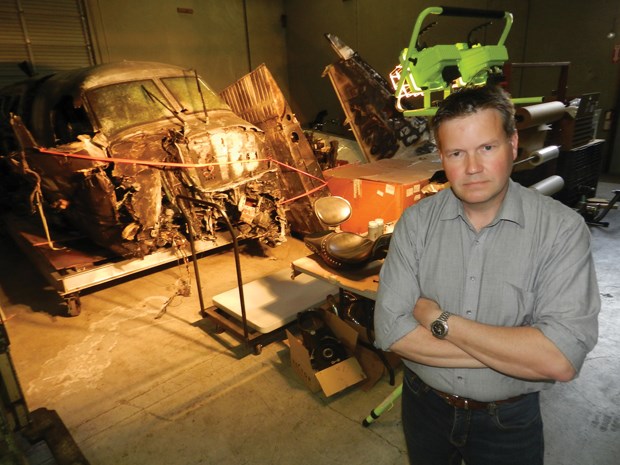Alec Moffat has become pretty good at jigsaw puzzles.
But it’s not the coffee table variety he’s used to piecing back together.
His come with twisted pieces of aluminum, shards of glass, and a variety of other materials often turned almost unrecognizable by the forces of a catastrophic air crash.
Moffat is a senior investigator and director of operations at RJ Waldron, a Richmond-based, aviation forensics investigation service that has, since the mid 1970s, been delving into wreckage of all types of aircraft to find out why they failed.
“Basically, the first thing we do with any aircraft, be it a helicopter or large plane, is start with the four corners of the aircraft,” Moffat said. “So, when you have collected all of the wreckage, we ask ourselves do you have the nose, the wingtips and the tail? And if you have all of that, then you collect everything else in between.”
The company got its start when founder, Bob Waldron, a metallurgist from UBC, had a friend who had been killed in an aircraft accident. But the official aircraft accident investigation could not determine the cause of the accident.
“So, he (Waldron) went and looked at the fractured parts and discovered there was a (metal) fatigue problem in one of the propellors and that’s what caused the accident,” Moffat said.
And once he did that more business started coming his came his way.
“He never intended to get into aviation, but it started with a small shop and one thing led to another,” Moffat added.
Today, the company is the largest of its kind in the country, operates globally, and is one of the best known in the relatively small, yet tight-knit industry of forensic aviation investigation.
While the jigsaw approach to the start of an investigation is akin to first finding the flat edges of the puzzle, Moffat said the process his three-person firm employs stops short of actually re-connecting the parts.
“You want to lay the pieces close to each other, but not touching because if there are any features within the fractures of the materials, they may explain the cause of the accident,” he said.
But once the overall reconstruction has been completed, then it’s time to look for anomalies within the mass of parts — components that may have broken due to metal fatigue or an overload of some kind.
Sometimes, clues or other information from an accident — reports from surviving passengers or crew, for example — can narrow down the search for answers.
Other times, the team at Waldron employ high-tech equipment, such as an electron microscope that can magnify items thousands of times, to look closely at the structure of materials to provide answers.
Components that have failed because of fatigue appear much different than those that have been forced apart, Moffat explained.
Other tell-tale clues to what may have happened in a crash focus on key elements of an aircraft.
Case in point is a medical helicopter from Chicago whose remains are neatly arranged in a section of Waldron’s warehouse section.
The chopper had been out for a test flight after dark following a round of maintenance when it crashed, killing its pilot.
“The NTSB (National Transportation Safety Board) out of the U.S. was unable to determine the cause, but suspected pilot suicide,” Moffat said, adding Waldron was hired by a law firm representing the deceased pilot to offer its interpretation of the crash.
“We noticed some strange things,” Moffat said, pointing to the helicopter’s tail rotor blade that was substantially intact, but bent in some places.
“It doesn’t have any rotational damage,” Moffat said. “These blades spin at a very high RPM, so if they contact anything, you’d expect them to be almost shredded.”
That indicates the blades were likely not rotating at all, or at a much slower rate than normal, pointing to a potential loss of control not linked to pilot error.
In another, separate warehouse, the remains of another helicopter that crashed killing one passenger was likely not a mechanical failure, but one concerning operation of the aircraft.
The chopper was used at a fishing resort that picked up two clients who were wet from their angling activities, and the windows of the helicopter’s cabin fogged over due to the excess moisture shortly after the flight took off.
Even with the de-fogging blowers activated — like those in a car — the pilot’s view was obscured and the aircraft went down.
“Once you’ve lost (visual) reference to the outside world, it’s very hard to control an aircraft,” Moffat said, adding recommendation on the still active case could focus on increased pilot training.
“Was the pilot also under a lot of pressure to get his passengers to another destination? Or since things usually run on a charge by the hour basis, was it a case of not wanting to wait another five minutes for the windows to clear properly?” Moffat said, adding “There’s usually never just one cause for a crash. There’s almost always multiple issues.”
Making sense of them all to provide answers can result in a high degree of satisfaction, Moffat said.
“There’s definitely the satisfaction in helping out the client, and in some cases it can help prevent a similar accident from happening again,” he said. “Really, that’s the ultimate goal of an investigation — to learn from it. It doesn’t always happen. But that’s what we strive for, whether it’s the TSB (Transportation Safety Board) or independent investigators.”



